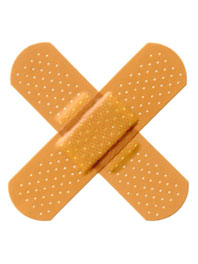ejection letters are like sports injuries. Play a sport, and eventually you’ll have at least a bump or bruise. Write for publication, and eventually you are going to earn a rejection letter.
Some of them won’t phase you—the rejection letter equivalent of a minor scrape. But some rejection letters will flatten you, often because the manuscript was a “sure sale.” Maybe you submitted it to an editor you’ve worked with repeatedly. Or it might be that the editor approached you, asking you to write a particular manuscript. How much more certain can you get? Still, rejection letters are unavoidable.
If you don’t know how to deal with it, a rejection letter can bench you for the season, putting you off writing for days or weeks or even months. The worst can be career ending. Just how a rejection letter affects your career depends on what you’ve done to prepare for it, how you handle it when it comes, and what you do after you’ve had some time to recover.
Preparing for the Unavoidable—Warming Up
When you play a sport, you can avoid or minimize injuries by warming up. Warming up stretches muscles in the same ways they move when you are actively playing. Warmed up muscles are flexible and ready to work.
For writers, warming up is just as vital. Again, you stretch muscles and get them ready to move in certain ways. In this case, you are getting your work ready to move through the submission channels. The way to warm up for this is to research possible markets as well as other pieces these markets have already published. This warm up stretches your creative muscle in several different ways.

“Stretch yourself by studying the market, and your manuscript has a better than average chance for success...”
Let’s say that you are working on a juvenile nonfiction book on farm and ranch life. It’s time to submit, so you warm up with a quick Amazon search which yields 599 results. Obviously, publishers are buying manuscripts on this topic, but is the topic saturated? Maybe, maybe not. You don’t know what these books are about or whom the target audience is. There might still be room for your story.
Stretch a little farther, focusing your topic. After all, you didn’t write about farm and ranch life in general. Your manuscript focuses on the tenuous nature of farming as done by many people in remote areas of our planet. You do another search, including food security and come up with only one book, The Good Garden by Katie Smith Milway.
This stretch has paid off. There is only one book competing directly with your own. Take a closer look at Milway’s book. It is nonfiction for ages four to eight. It is set in Honduras. Your piece, set in Thailand, is for a slightly older audience, ages eight to twelve. You’ll have little or no competition even in the crowded topics of agriculture and food. Warming up by researching the market tells you where your book fits in—something the editor you submit your work to will want to know.
You still aren’t done warming up. You know there is space in the market for your manuscript, but you need a publisher. Stretch just a bit farther—research individual markets. Back to your imaginary manuscript. You want to get it into the hands of students. This would be easiest with a publisher that markets to schools such as Boyds Mills Press. Looking up their listing in the Children’s Writer’s and Illustrator’s Market, you learn that Boyds Mills Press publishes nonfiction for all ages, involving nature/environment, history, science, animals, and multicultural.
So far so good. But that isn’t really much information; this is supposed to be a serious stretch. Do a quick search, and you’ll find their Fall 2010 catalog online. You look through it to see how fiction balances with nonfiction (your manuscript), whether or not Boyds Mills publishes new authors (you don’t have a book), and how much of their work is about the U.S. or Europe versus other countries. Boyds Mills publishes slightly more nonfiction than fiction, which is good news for your manuscript; but many of their authors are highly published or experts in their field. That said, the two “new to Boyds Mills” authors are also brand new—these are their first books. As for setting, there is a balance between European and American settings, and those books with no clear focus on the West.
Other things you might want to consider when researching markets are whether or not the publisher only handles series and if this publisher has recently published a book that would compete too closely with yours.
A similar analysis could be done of a magazine or e-zine, looking at topics, fiction versus non-fiction, and whether writers are new to the magazine or are on staff, as well as sidebars (do they want them?) and illustrations (does the author supply photos?). Study several catalogs or the backlist of a book publisher and six months to a year of a periodical.
Stretch yourself by studying the market, and your manuscript has a better than average chance for success—you will know if there is in fact an interest in this kind of manuscript and a space in the market for your manuscript in particular. You will also know whether or not your chosen publisher is a good match for both you and your work. All of this increases your chances for a painless, injury-free submission.

“There are three steps to immediate treatment: dealing with your initial reaction, interpreting the editor’s comments, and taking another look at your work alongside the market.”
Handling Injuries When They Come—Immediate Treatment
Even athletes who stretch suffer injuries. Similarly, in spite of excellent market research, you will eventually suffer through a rejection letter injury simply because you don’t control all of the variables in publishing. You have no way of knowing what other manuscripts are sitting on the editors’ desks, if they have filled their current slots, or what their individual likes and dislikes in a manuscript may be. In spite of your efforts, you will eventually receive a rejection letter.
At that point, how quickly you recover depends on what treatment you get when the injury takes place. There are three steps to immediate treatment: dealing with your initial reaction, interpreting the editor’s comments, and taking another look at your work alongside the market.
Sometimes dealing with your immediate reaction will be a breeze. “Oh, well. It was a long shot.” Other times you will react more strongly. Even when the editor gives you personal feedback, some rejections hit and hit hard. You’ll be hurt and angry.
This type of injury requires icing down. You need to cool off. Now isn’t the time to read the editor’s comments because you won’t absorb them anyway. You might skim to the end of the letter to see if she asked for a rewrite or wants to see more of your work. If so, it might help you chill. If not, go work off some of that bile. Seriously. Scrub the shower floor. Go for a run. I’ve been known to pull weeds, tear out shrubs, and paint my nails a putrid green. You put a lot of work into that submission, and most of us have a deep emotional connection to our work. Just don’t do anything stupid.
Seriously. Stay off the Internet. Do not post to public chat rooms or tweet about what a dolt the editor is. Other authors have done this, or I wouldn’t even be bringing it up. Feel the need to go online? Play Dungeons and Dragons online. Taking a swing at a handful of hobgoblins is fine. Posting messages? Not so much. Bitching to your writing buddies? Sending a scorching e-mail to your husband? Again, fine. You’re going to have to expend some energy and chill out. Get started and get over it.
My writing buddy Darcy Pattison gives herself two days max. After two days, she forces herself to sit down and look at the letter again to see just what the editor had to say.
Depending on how long and/or complicated the comments are, I sometimes do more than just read them. I take notes. “Character not fully developed.” “Not enough beats.” “What is the purpose of chapter two?”
Even if you got a simple form rejection, the next step is the same. Take another look at the market. Check market listings, the publisher’s catalog, or back issues—whatever can give you a feel for their audience, what they publish, and whom their authors are. Does it still feel like a good match? Or has something changed? Maybe the issue that came out between the time you submitted and when you got that rejection brings something new to light.
Once you’ve studied the markets, reread your manuscript. As you do, keep the editor’s comments and/or the market analysis in mind. Can you use these comments to improve your work? Even before you submitted to this market, maybe you had a niggling doubt about the characterization. Or the action toward the middle of your novel may have seemed a little ho-hum. You may spot some ways that you can improve your work even if these improvements don’t relate to the comments. How-tos like Writing Picture Books by Ann Whitford Paul or Novel Metamorphosis by Darcy Pattison can help.
As you study your manuscript, you may realize it isn’t a good match for this market. Perhaps the editor commented on your ending. When I submitted my second readers theater manuscript to READ, I had no idea that their biographies had to have a happy ending. The subject of my piece died penniless. I couldn’t fix the ending where READ was concerned, but I learned what to look for in other markets.
Finish these steps in the immediate treatment of your injury, and you’ll be ready for the next step in your recovery.

“The best cure for a rejection-based injury is, after all, a sale; and the only way to get this sale is through the physical therapy called resubmitting.”
Physical Therapy
Even when an athlete immediately ices down an injury, physical therapy is often necessary to get back into the game. For a writer, physical therapy means resubmitting that manuscript.
While you are making the necessary changes, big or small, take another look at your markets. You are still trying to sell your manuscript on sustainable agriculture in Thailand. Boyds Mills Press, choice number one, turned it down. You broaden your market research to include publishers that specialize in social justice. This time you find Tilbury House, a publisher who focuses on books that honor diversity and tolerance. You’re not sure about the fit until you see Give a Goat by Jan West Schrock about a class who buys a goat for a needy farming family. Again, you’ll have to compare yourself and your work with what Tilbury House does. You might even research several potential markets at once, ranking them from your favorite to your least favorite, so you can get this piece back out quickly should the need arise.
The point is GET IT BACK OUT THERE. The best cure for a rejection-based injury is, after all, a sale; and the only way to get this sale is through the physical therapy called resubmitting. When you do, you know you are ready to get back into the game.
Post-Recovery—Getting Back Out on the Field
“Wait just a minute!” I can hear you from here. “I got my manuscript back out. I’m already back on the field.”
Not quite, but you are close.
To get back into the game, if possible, you need to send something new to the editor who rejected you. Check the manuscripts languishing on your hard drive. Flip through your files. You know what this market publishes. Do you have anything suitable? Send it and thank the editor for taking the time to look at your last manuscript.
It may seem counterintuitive to remind the editor of a failed submission, but editors want to work with writers who stick things out. Editors want to know that you’ll last through rewrites and the various headaches publishing sometimes involves. They want to know you are a seasoned athlete who can handle the game’s ups and downs.
If you don’t have anything suitable, can you work something up? If not, just send a brief thank you note. Brief. The editor isn’t your BFF. “Thank you for taking the time to respond to my submission, manuscript XYZ.” If you could quickly work up something new, let the editor know another submission is coming. “You will be receiving ABC shortly.”
Then, make it so.

“The more pieces you have in submission, the greater your chances for making individual sales and the less hope you have riding on any single manuscript.”
Good Overall Fitness
The writers who have the best recovery rate have good overall writing fitness. This means they don’t have all of their hopes hanging on one manuscript. The more pieces you have in submission, the greater your chances for making individual sales and the less hope you have riding on any single manuscript. So, you got one back. You still have fourteen pieces under consideration.
Not there yet? Get to work. If you’ve followed my instructions, you’ll soon have two manuscripts in circulation. When you do, don’t turn into a couch potato. Head back to the gym—your desk. Find another market you want to submit to and then get something ready to go. Or hit the track. Go through your manuscripts again. Find something else to get out the door.
Writing. Researching markets. Submitting. Go through these steps, and your fitness level will increase. Soon, you’ll be buff. You’ll still get rejection letters. After all, you’ll have quite a bit in circulation, but you’ll be able to ice down most rejection injuries with a cup of coffee and a little fuss. Then you’ll be back in the game.
After all, you’re a pro.
***

Sue Bradford Edwards is a writer and book reviewer who creates scenes in her home office in St. Louis, Missouri. Read her work at Education.com and Prayables.com. To find out more about her or her writing, visit her blog, One Writer's Journey, her book review blog, The Bookshelf, or her website.
-----
Enjoyed this article? Check out Sue’s other articles on WOW!:
Creating Scenes
Navigating the Fantastic: Rules for Writing Fantasy
How to Write a Picture Book
How to Combat Writer's Block
Interview with Simone Elkeles, Teen Romance Author
Related Articles
Write Nonfiction for Kids? Break Out with a High-Concept Idea
How to Diagnose Your Novel's Strengths and Weaknesses
How to Trim the Fat from Your Manuscript
Red Pencil Round-Up: Self-Editing for Fiction Writers
Writing for the Educational Market
5 Things You Need to Know to Write for Magazines